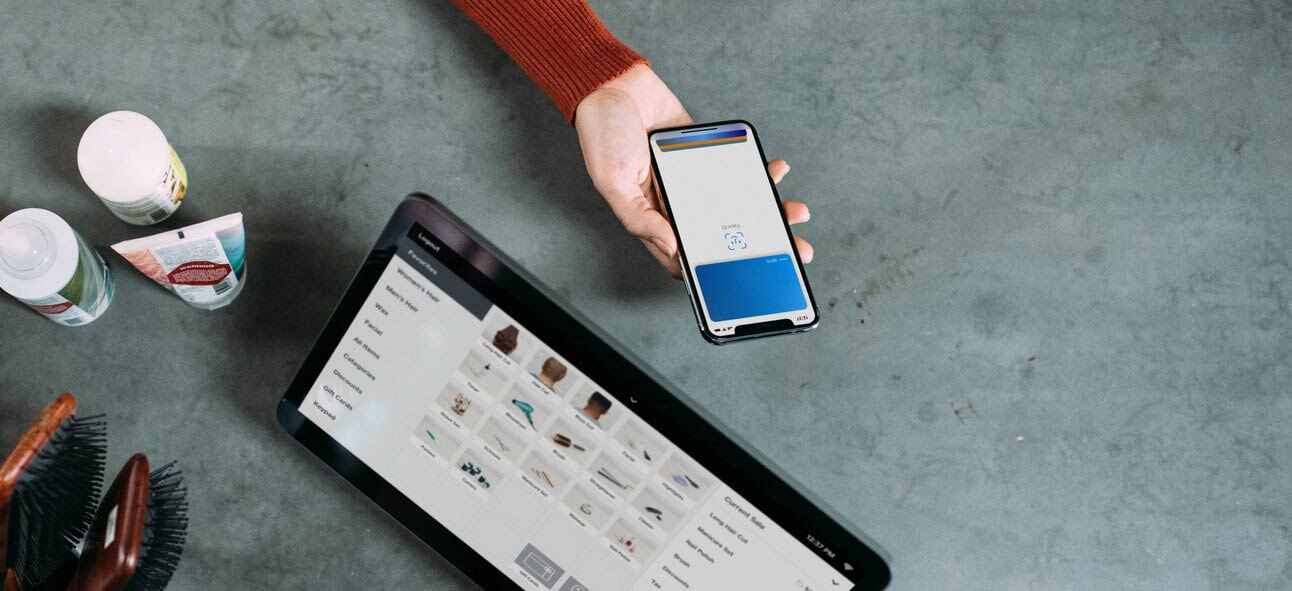Mobile is everywhere. Over 50% of all online e-commerce sales in Europe now happen through mobile. Given the ease and convenience they provide, it’s no surprise that mobile payments have become people’s go-to choice for making payments, whether online or in stores. This makes them indispensable for today’s businesses. In this article, we tell you about how you can accept mobile payments and maximize your sales.
What are mobile payments?
A mobile payment is an electronic payment made through a mobile device, such as a smartphone, a tablet, or a smartwatch. Merchants can even accept card payments using just their mobile phones. Because of how ubiquitous they are and easy to use, mobile payments have become quite popular.
Mobile payments can be used for various types of payments, including:
- Point-of-sale purchases at a physical store
- Online purchases
- Subscription payments
- Bill payments
- Staff payments
Types of mobile payments
1. Browser-based mobile payments
Browser-based mobile payments are those where a customer opens a merchant’s website on their mobile phone (on a mobile browser), where they enter their payment info into the checkout page of the website, and complete their purchase. The payment is then processed by the merchant’s payment services provider. Some websites come with their own built-in payments systems (for example, Shopify sites) while in others, shoppers are redirected to an external webpage (like PayPal, for example), where they fill in their payment data and complete their transaction. Either way, the entire shopping and paying process happens within the mobile browser.
2. In-app payments
In-app payments are same as browser-based payments, only that they happen within a mobile app rather than a browser. At checkout, customers enter their payment data into the app, and the payment is processed in the same way as a regular browser-based payment. In-app payments are popular with larger businesses, but anyone can build a mobile app for their business.
Research shows that mobile app users tend to spend 19x more time per month shopping as compared to website users. Data shows that consumers globally prefer shopping through mobile apps over mobile websites, as the experience is much better. Mobile apps also increase conversion rates 3x, when compared to mobile websites. These might just be enough reason to get you started with your own mobile app, if you don’t have one already.
3. Mobile credit card payments
Merchants can accept card payments directly using their mobile phone as a point of sale (POS) system. They will need a mobile card reader that is designed to accept mobile payments, which can be hooked up to the mobile phone to easily accept card and e-wallet payments from customers.
4. Contactless payments
Contactless payments have been on the rise since the pandemic. Two out of three Europeans report using contactless payments frequently. Contactless payments, also called Tap to Pay, use NFC technology to make payments in-store smoothly and securely. Customers just need to tap their contactless card or mobile phone to the merchant contactless POS terminal (or NFC-enabled phone). They do not have to type a PIN, enter their payment details, or sign.
Another option is to scan a QR code to pay. Customers can open their e-wallet apps on their smartphones, such as PayPal or Apple Pay, scan the merchant QR code, and done. Contactless payments also use multi-factor authentication, which makes them super secure. To accept contactless payments, a merchant will need an NFC reader (or a QR code). Set up is quite simple, quick, and relatively cheaper.
Why use mobile payments? What are the benefits?
Mobile payments have several benefits. Here’s a look at a few:
- Higher customer satisfaction: Customers can pay easily and quickly with mobile payments. This speeds up the checkout process, and reduces long queues at physical stores. This improves the customer experience.
- Higher sales: mobile payments offer more payment choice, thus helping you reach a wider audience and capture revenue at various locations. This boosts your sales and revenue.
- Higher customer engagement: Mobile payments give you access to richer customer data, which can be easily integrated with customer loyalty programs, offers, and incentives, that are linked to a customer’s mobile device. This helps you to easily engage with your customers and offer them more.
- More secure payments: mobile payments use stronger security protocols, leading to more secure payments. This includes multi-factor authentication and tokenization to secure transactions and keep customer data secure.
- More efficient accounting: mobile payment systems can be linked up with your accounts systems, leading to more transparent data exchange. This helps in more efficient accounts keeping, reduces errors, and makes reconciliation simpler.
How to accept mobile payments?
Mobile payments are fairly simple to set up. Let’s consider both online and offline store cases.
If your business already has an online store, this is what you need to do:
- Sign-up with a payments service provider, like Novalnet, who can help you accept mobile payments.
- Set up the payment infrastructure on your website. If you use website platforms such as Shopify, Magento, or WooCommerce, they come with their own in-built payment functionality. Your payments service provider will offer payment plugins to connect your online store to the payment gateway. Novalnet provides instant plugins for all popular website platforms that can be setup within minutes, and with zero coding.
- Link up your merchant business account with your payments setup, and your ready to start accepting mobile payments.
If your business (also) has a physical store, here’s what you need to do:
- Buy a mobile card reader, which you can connect with your mobile phone to turn it into a mobile POS. Once the setup is done, you can easily accept credit/ debit card payments using just your mobile phone. Just ensure the mobile card reader also accepts contactless payments.
- Register your business with the mobile payment system you are using.
- Link up your merchant business account with your mobile payments system, and you’re ready to go.
After you have finished setting up your mobile payments, you can inform your customers and prospective shoppers that you accept mobile payments. You can inform your audience through your website, emails, and social media channels. You could also offer incentives to shoppers to encourage them to pay through their mobile device(s).
How Can Novalnet Help
We can help you accept mobile payments easily. Our instant plug-ins and APIs help you set up mobile payments quickly, with minimal coding and hassle. We help Europe’s leading brands to process payments smoothly. Our technology allows you to accept payments globally in 125+ currencies in 150+ automated country-specific payment methods. Plus, AI-based risk management solutions and advanced analytics solutions help you design the best payment experiences for your customers, all in a fully secure PCI DSS-certified environment.
Reach out to us today to know more about how we can help.
Jose Augustine is the Chief Business Development Officer at Novalnet with extensive experience in European payment industry and a knowledge powerhouse.












